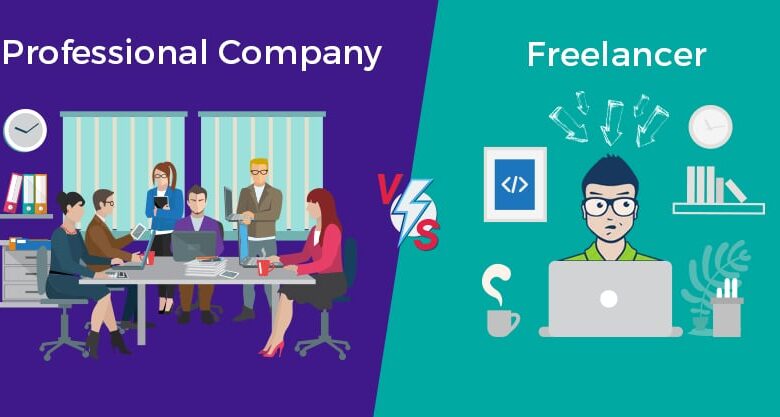
Freelancers Show Up as You or a Company?
Freelancers should you show up as you or a company – Freelancers: Should you show up as you or a company? This is a question many independent professionals grapple with. The choice dramatically impacts everything from your tax burden and legal liability to how clients perceive your brand and the opportunities available for growth. It’s not a simple “one size fits all” answer, and the best approach depends on your individual circumstances, goals, and risk tolerance.
Let’s dive into the complexities of this decision and help you figure out what’s right for you.
We’ll explore the legal and financial implications of each path, examining the differences in tax obligations, contracts, and liability. Beyond the paperwork, we’ll also delve into the crucial area of client perception, discussing how presenting as an individual freelancer versus a company can influence your brand image and ability to attract high-value clients. Finally, we’ll consider the long-term implications, looking at scalability, growth potential, and the challenges and advantages of each model.
By the end, you’ll have a clearer understanding of the trade-offs involved and be better equipped to make an informed decision for your freelance career.
Legal and Tax Implications
Choosing between operating as a sole freelancer or forming a company significantly impacts your legal and tax obligations. The best structure depends on your individual circumstances, risk tolerance, and long-term goals. This post explores the key differences.
Legal Structures: Sole Freelancer vs. Company
Operating as a sole freelancer means you and your business are legally indistinguishable. All profits are considered your personal income, and you are personally liable for all business debts and legal actions. In contrast, forming a company (e.g., LLC, S Corp, or C Corp in the US; Limited Company in the UK; Corporation in Canada) creates a separate legal entity.
This offers limited liability, protecting your personal assets from business debts, but involves more complex administrative requirements. The choice influences everything from contract negotiation to risk management.
Tax Implications in Different Countries
Tax implications vary considerably depending on your chosen structure and country of residence.
United States
Sole freelancers in the US report their income on Schedule C of Form 1040. They pay self-employment taxes (Social Security and Medicare) in addition to income tax. Companies (LLCs, S Corps, and C Corps) have different tax structures. LLCs are typically pass-through entities, meaning profits and losses are passed through to the owners’ personal income tax returns.
S Corps and C Corps have more complex tax structures, often involving corporate income tax and potentially additional taxes on distributions to owners.
United Kingdom
UK sole freelancers pay income tax and National Insurance contributions on their profits. Limited companies pay corporation tax on their profits, and directors may also pay income tax and National Insurance on their salaries and dividends.
Canada
Canadian sole freelancers report their income on their personal tax return. They pay income tax and self-employment taxes. Corporations in Canada are subject to corporate income tax, and dividends paid to shareholders are taxed separately.
Contract Examples
Contracts differ significantly depending on whether you operate as a freelancer or a company. A contract with a sole freelancer typically focuses on deliverables, payment terms, and intellectual property rights. It might include a clause specifying the freelancer’s personal liability. A contract with a company will likely be more formal, detailing the company’s liability, insurance coverage, and potentially specifying payment to the company’s bank account rather than the individual’s.
Liability Comparison, Freelancers should you show up as you or a company
| Aspect | Sole Freelancer | Company |
|---|---|---|
| Personal Liability for Business Debts | Unlimited | Limited |
| Liability for Business Actions | Personally liable | Company liable (personal assets generally protected) |
| Legal and Regulatory Compliance | Simpler | More complex (e.g., corporate filings, annual reports) |
| Tax Burden | Self-employment taxes apply | Corporate taxes, potentially additional taxes on distributions |
Client Perception and Brand Building

Source: freshbooks.com
Choosing to present yourself as an individual freelancer or a company significantly impacts how clients perceive you and, consequently, your success. This decision influences your branding efforts and overall professionalism, affecting client acquisition and long-term business growth. Understanding these nuances is crucial for building a strong and reputable freelance career.The perception of freelancers varies widely depending on their chosen structure.
Clients often view individual freelancers as more accessible and potentially less expensive, but may also perceive them as less established or less capable of handling large-scale projects. Conversely, companies often project an image of greater professionalism, experience, and stability, but might be seen as less flexible or potentially more costly. This perception directly impacts the types of clients attracted and the projects secured.
Freelancer Branding and Professionalism
Branding is paramount regardless of the chosen structure. A strong brand builds trust and credibility. For individual freelancers, a well-defined personal brand emphasizing expertise and specialization can counterbalance perceptions of limited scale. This might involve crafting a professional website, showcasing testimonials, and actively participating in relevant online communities. For freelancers operating as companies, branding focuses on projecting corporate identity, stability, and professionalism.
This could involve a carefully designed logo, professional website, and consistent communication across all platforms. The key in both scenarios is consistency and a clear message communicating value to potential clients.
Examples of Successful Freelancer Brands
Consider the case of a freelance graphic designer operating as an individual. By consistently delivering high-quality work and building a strong online presence through platforms like Behance and Dribbble, they cultivate a personal brand synonymous with creativity and expertise. Their portfolio becomes their most powerful marketing tool. Conversely, a successful freelance web development agency operating as a company might invest in a strong brand identity, including a professional logo, consistent messaging, and case studies showcasing their expertise in complex projects.
The agency’s brand builds trust and credibility, attracting clients seeking larger-scale solutions.
Client Perception Comparison
| Feature | Individual Freelancer | Freelancer as a Company |
|---|---|---|
| Perceived Professionalism | Can be perceived as less formal; depends heavily on personal branding. | Generally perceived as more professional and established. |
| Perceived Reliability | May be perceived as less reliable, especially for large projects, unless proven otherwise. | Generally perceived as more reliable due to the perceived structure and stability. |
| Client Acquisition | Relies heavily on networking, referrals, and online presence. | May benefit from larger-scale marketing efforts and potentially attract larger clients. |
| Pricing | Often perceived as more affordable. | Often perceived as more expensive due to overhead costs and perceived value. |
Professionalism and Credibility
Building a strong professional image is paramount for freelancers, whether operating as individuals or under a company banner. Credibility, the bedrock of any successful freelance career, stems from consistently demonstrating competence, reliability, and ethical conduct. This applies equally to solo freelancers and those operating within a formally structured business. The approach to building this image, however, differs slightly depending on the chosen structure.
The key difference lies in the perception of risk. Clients often perceive less risk when working with established companies, due to perceived greater resources and accountability. Individual freelancers, however, can leverage their personal brand and expertise to build trust and overcome this perception gap. Both approaches require a deliberate and consistent effort to project professionalism.
Key Elements of a Professional Image
Several key elements contribute to a professional image, regardless of whether you operate as an individual or a company. These include consistent branding, clear communication, timely responses, professional documentation (contracts, invoices, etc.), and a polished online presence. For companies, maintaining a consistent brand identity across all platforms is crucial. For individuals, showcasing expertise through a well-maintained portfolio and testimonials is key.
Building Credibility as an Individual Freelancer
Individual freelancers build credibility through demonstrating their expertise and reliability. This can be achieved through building a strong online portfolio showcasing successful projects, actively seeking and providing testimonials from satisfied clients, and consistently delivering high-quality work on time and within budget. Participating in relevant industry events and networking can also significantly boost credibility.
Building Credibility as a Company Representative
Companies build credibility through establishing a strong brand identity, showcasing their team’s expertise, and maintaining a professional corporate image. This involves creating a well-designed website, publishing case studies, and securing positive client reviews. A clearly defined company structure and legal registration further enhance credibility. Consistency in communication and responsiveness to client inquiries is also critical.
Effective Communication Strategies
Effective communication is crucial for both individual freelancers and companies. For individuals, clear, concise, and personalized communication is essential. This might involve tailoring proposals to each client’s specific needs and maintaining regular updates on project progress. For companies, communication should be consistent with the brand’s voice and tone, ensuring all communication channels (email, phone, website) convey a professional image.
Clear communication protocols within the company are also crucial to maintain consistency in client interactions.
Best Practices for Maintaining a Professional Online Presence
Maintaining a professional online presence is vital for both individual freelancers and companies. This involves creating a professional website or online portfolio, using professional email addresses, and actively managing online reviews. For individuals, maintaining a consistent brand across all social media platforms is important. For companies, ensuring the website is up-to-date, user-friendly, and reflects the company’s brand is crucial.
Regularly monitoring online reputation and addressing negative feedback promptly are also essential.
Scaling and Growth Opportunities

Source: ebonywblog.com
Scaling a business, whether as a freelancer or a company, presents distinct challenges and opportunities. The path to growth differs significantly depending on the chosen structure, impacting everything from operational efficiency to long-term potential. Understanding these differences is crucial for strategic planning and sustainable expansion.The ease of scaling operations differs dramatically between freelancing and operating as a company.
Freelancers, by their nature, are often limited by their individual capacity. Growth typically involves increasing personal productivity or selectively taking on more lucrative projects. Companies, on the other hand, can scale more readily by hiring employees, outsourcing tasks, and investing in technology to automate processes. This allows for a more significant increase in output and revenue.
Scaling as a Freelancer versus a Company
Freelancers face a natural ceiling in their capacity for growth. Their income is directly tied to the hours they work. Expanding often means working longer hours or improving efficiency, potentially leading to burnout. Companies, however, can achieve exponential growth by strategically allocating resources and expanding their workforce. They can invest in marketing and sales to acquire more clients, and delegate tasks to specialized employees, leading to increased productivity and revenue.
For example, a freelance graphic designer might find it difficult to manage more than a few clients simultaneously, while a design agency can employ multiple designers and handle a much larger volume of projects.
Growth and Expansion Potential
The potential for growth is significantly higher for companies compared to freelancers. Companies can diversify their services, target wider markets, and explore new revenue streams. They can also pursue strategic partnerships and investments to fuel expansion. Freelancers, while capable of steady growth, are often constrained by their individual expertise and time limitations. Consider a freelance writer: they might increase their income by writing more articles, but their capacity is limited by the number of hours in a day.
A company, however, could create a content creation agency, employing multiple writers and expanding into various content formats, thereby achieving a much greater scale.
Advantages and Disadvantages of Hiring Subcontractors
Hiring subcontractors presents both advantages and disadvantages, regardless of whether you operate as a freelancer or a company.
Advantages of Hiring Subcontractors
Subcontracting offers access to specialized skills and expertise without the commitment of full-time employment. This is particularly beneficial for handling short-term projects or tasks requiring specific skills not possessed by the core team. It also provides flexibility and scalability, allowing businesses to adjust their workforce based on project demands. Cost savings can also be significant, as subcontractors often charge less than full-time employees, excluding benefits and overhead.
So, you’re a freelancer – should you operate as a sole proprietor or establish a company? It really depends on your goals and the type of clients you’re targeting. Building a strong online presence is crucial, and that often means mastering video marketing, which is why I found getting it on with youtube so helpful. Understanding YouTube’s algorithm can significantly boost your visibility, whether you’re pitching yourself as an individual or a brand.
Ultimately, the “you vs. company” decision will impact how you present yourself in those videos.
Disadvantages of Hiring Subcontractors
Managing subcontractors requires careful planning and oversight to ensure quality and timely delivery. Communication challenges and potential for miscommunication can arise, impacting project timelines and outcomes. Quality control can also be an issue if proper oversight is not implemented. Furthermore, relying heavily on subcontractors can create a less cohesive team and potentially impact overall brand consistency.
Expanding a Freelance Business: A Flowchart
The following flowcharts illustrate the expansion process for a freelance business under two models: Freelancer and Company.
Freelancer Model Expansion Flowchart
This flowchart depicts a linear expansion path focused on increasing personal capacity and efficiency. Each step builds upon the previous one, concentrating on improving individual skills and client acquisition.
Start -> Identify Niche & Specialisation -> Improve Skills & Efficiency -> Network & Build Client Relationships -> Raise Prices Strategically -> Delegate Simple Tasks (if possible) -> Evaluate Need for Outsourcing -> Growth
Company Model Expansion Flowchart
This flowchart illustrates a more complex, multi-faceted approach to expansion. It involves establishing a formal business structure, building a team, and actively pursuing growth strategies.
Start -> Develop Business Plan -> Secure Funding -> Establish Legal Entity -> Hire Employees/Subcontractors -> Develop Marketing Strategy -> Expand Service Offerings -> Diversify Revenue Streams -> Scale Operations -> Growth
Insurance and Risk Management
Freelancing, whether as a sole proprietor or a limited company, presents unique risks. Understanding and mitigating these risks through appropriate insurance and proactive risk management strategies is crucial for long-term success and financial security. The level of protection and the types of insurance needed differ significantly depending on your chosen business structure.Insurance and risk management strategies are not merely about avoiding potential financial losses; they are about safeguarding your livelihood, protecting your reputation, and ensuring the continuity of your business.
A robust approach allows you to focus on what you do best – delivering exceptional work for your clients.
Insurance Needs for Freelancers Operating as Individuals vs. Companies
The insurance needs for sole proprietors (individuals) and limited companies differ significantly. Sole proprietors generally have personal liability for business debts and actions, while limited companies offer a degree of separation between the personal assets of the owner and the company’s liabilities. This difference directly impacts the types and extent of insurance coverage required. For example, a sole proprietor might need comprehensive general liability insurance to cover potential claims related to their work, whereas a limited company might require more specialized insurance for directors and officers.
Risk Management Strategies for Sole Proprietors
For sole proprietors, risk management involves a multifaceted approach focusing on personal liability protection and business continuity. This includes comprehensive general liability insurance, professional indemnity insurance (if applicable to your profession), and potentially personal accident insurance. Regularly reviewing contracts, maintaining detailed records, and implementing robust client communication protocols are crucial risk mitigation steps. Proactive steps such as ensuring your home workspace meets safety standards and maintaining accurate financial records are also vital.
Risk Management Strategies for Limited Companies
Limited companies benefit from the separation of personal and business liabilities, but this doesn’t eliminate the need for robust risk management. Key strategies include directors and officers (D&O) insurance, which protects directors from personal liability for wrongful acts, and employer’s liability insurance if you employ staff. Maintaining a strong corporate governance structure, adhering to company regulations, and ensuring adequate financial reserves are crucial for mitigating risks.
Regular legal and financial reviews can identify potential vulnerabilities before they escalate into major problems.
Examples of Potential Risks and Mitigation Strategies
A common risk for freelancers is client disputes. For both sole proprietors and limited companies, clearly defined contracts with payment terms, dispute resolution clauses, and intellectual property rights are crucial. For a sole proprietor, a poorly drafted contract could directly impact personal assets, highlighting the importance of legal counsel. For a limited company, a similar issue could affect the company’s reputation and financial stability.
Another example is equipment failure. Having appropriate insurance and regular maintenance schedules mitigate this risk for both structures. Cybersecurity breaches are also a major concern, requiring investment in robust security measures and cyber liability insurance, regardless of the business structure.
Insurance Options and Their Relevance
The following table Artikels common insurance options and their relevance to each structure:
| Insurance Type | Sole Proprietor Relevance | Limited Company Relevance |
|---|---|---|
| General Liability Insurance | High – protects against claims of bodily injury or property damage | Medium – covers business operations but liability may be limited |
| Professional Indemnity Insurance (Errors & Omissions) | High – protects against claims of negligence or professional misconduct | High – protects the company’s reputation and financial stability |
| Public Liability Insurance | High – covers injury or damage caused to a third party | Medium – often covered under general liability but can be a separate policy |
| Cyber Liability Insurance | High – protects against data breaches and cyberattacks | High – crucial for protecting sensitive client data |
| Directors & Officers (D&O) Insurance | Not applicable | High – protects directors from personal liability for wrongful acts |
| Employer’s Liability Insurance | Not applicable (unless employing staff) | High – if employing staff, it’s legally required in many jurisdictions |
Project Management and Workflow: Freelancers Should You Show Up As You Or A Company
Freelancing and working within a company necessitate vastly different approaches to project management. While both require organization and effective time management, the scale, resources, and inherent responsibilities differ significantly, impacting workflow strategies and the tools employed. Understanding these distinctions is crucial for success in either environment.Project management as a freelancer often involves juggling multiple projects concurrently, with limited support staff.
In contrast, company-based project management usually involves a more structured approach with dedicated teams, established processes, and readily available resources. This difference fundamentally shapes the workflow and project management tools utilized.
Freelancer Project Management Workflow Strategies
Effective freelancer workflows prioritize individual efficiency and adaptability. They must be flexible enough to handle unexpected changes and client requests while maintaining consistent progress across multiple projects. A common strategy involves employing time-blocking techniques, prioritizing tasks based on urgency and client deadlines, and using project management software to track progress and maintain client communication. This requires a high degree of self-discipline and proactive problem-solving.
Company Project Management Workflow Strategies
Company project management often utilizes established methodologies like Agile or Waterfall. These methodologies provide a structured framework for project execution, defining roles, responsibilities, and timelines. Teams collaborate using project management software, and regular meetings ensure alignment and address potential roadblocks. A clear chain of command and established processes streamline workflow and minimize potential conflicts.
Project Management Tools for Freelancers and Companies
Several tools effectively manage projects, regardless of the structure. For freelancers, simple tools like Trello or Asana can effectively manage tasks and deadlines. More complex projects might benefit from specialized software like Monday.com or ClickUp. These platforms offer features like task assignment, progress tracking, and communication tools. Companies often leverage enterprise-grade solutions such as Jira or Microsoft Project, which offer advanced features for large-scale projects and team collaboration.
These tools often integrate with other business applications, enhancing overall efficiency.
Project Proposal Structuring: Freelancer vs. Company
A project proposal’s structure subtly shifts depending on whether it’s presented by a freelancer or a company. A freelancer’s proposal might emphasize their individual expertise and experience, highlighting past successes and a personal approach to client collaboration. It would focus on the individual’s skills and ability to deliver results efficiently. In contrast, a company proposal typically emphasizes the company’s established processes, resources, and team expertise.
It showcases a broader range of services and a more formal approach, focusing on the organization’s capabilities and track record. Both, however, should clearly define project scope, timeline, deliverables, and pricing.
Ultimate Conclusion

Source: hestabit.com
Ultimately, the decision of whether to operate as an individual freelancer or a company is deeply personal and strategic. There’s no universally “correct” answer; it’s about aligning your structure with your long-term goals, risk tolerance, and the specific nature of your work. Weighing the legal, financial, and branding implications carefully will help you choose the path that best supports your freelance journey.
Remember, it’s not set in stone; you can always reassess and adjust your approach as your business evolves. So, consider your options, plan carefully, and choose the path that best suits your unique circumstances.
FAQ Corner
What are the common legal structures for freelancers?
Common structures include sole proprietorship, LLC (Limited Liability Company), and S-corp. The best choice depends on your location and business needs.
How do I choose the right insurance for my freelance business?
This depends on your field and risk factors. Professional liability insurance (errors and omissions) is often crucial, alongside general liability if you have physical interactions with clients.
Can I switch between operating as a freelancer and a company later?
Yes, but it typically involves administrative steps and may have tax implications. Consult with a legal and financial professional to ensure a smooth transition.
What if I want to hire subcontractors? How does that impact my structure?
Hiring subcontractors adds complexity regardless of your structure. You’ll need to manage contracts, payments, and potentially tax implications for those you hire. A company structure might offer more formal mechanisms for this.





